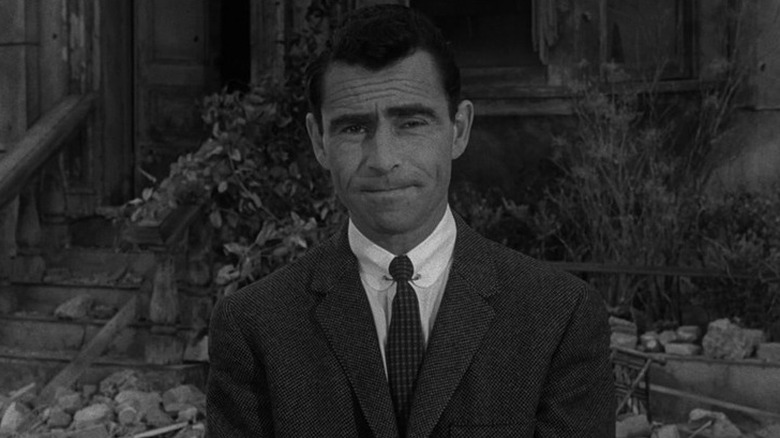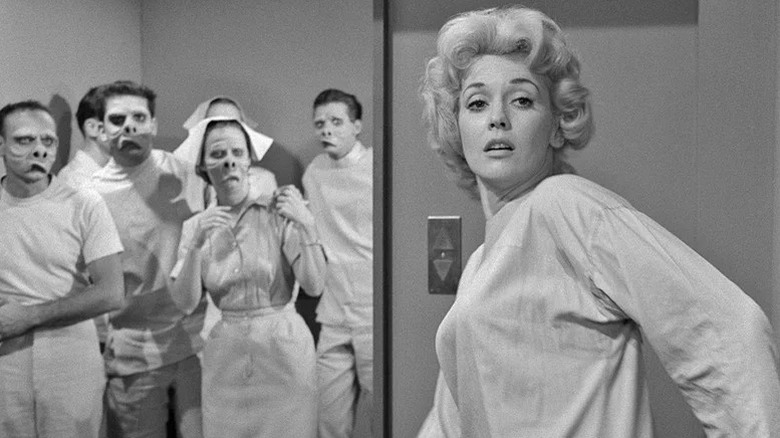Why The Twilight Zone's Original Pilot Episode Was Rejected
We may receive a commission on purchases made from links.
"The Twilight Zone" ran for 156 episodes total, and that's not even counting the extra backlog from the three attempts at rebooting the series (in 1985, the short-lived 2002 "Twilight Zone," and then Jordan Peele's 2019 attempt). That long, television-defining legacy all began in 1959 with the first aired "Twilight Zone" episode, "Where Is Everybody?"
An amnesiac man (Earl Holliman) awakens in the desert and walks to a seemingly abandoned town. (Reportedly, Serling was inspired by walking through an empty set on a movie studio lot.) Soon, he's asking the question that gives the episode its title.
The twist? Our lead is actually astronaut Mike Ferris. He's undergoing a training exercise in an isolation chamber to see if he can handle a trip to the Moon by himself. When the episode began, he'd been in the chamber for three weeks. The town was a hallucination because the isolation had finally gotten to him. The episode ends with Ferris being "rescued," still intending to go to the Moon.
"Where Is Everybody?" has a tidy and pretty sunny ending. It has the themes that became typical in "The Twilight Zone" — mystery, isolation, the possible end of the world — but the ending is all about deflating the earlier tension. It makes some sense; as the show's pilot, you don't want it to get too out there and turn off future viewers. That's what the executives at CBS thought.
You see, "Where Is Everybody?" was not Serling's originally-pitched pilot for "The Twilight Zone." The script he first sold to CBS was called "The Time Element," about a man named Peter Jenson visiting psychiatrist Dr. Gillespie to discuss dreams about the 1941 Pearl Harbor attack.
In his dream, Jenson is aware of the forthcoming attack and tries to unsuccessfully warn everyone else. The denouement reveals that Jenson had actually died in the attack years earlier and, evidently, it was his ghost visiting Gillespie. "The Time Element" aired in November 1958 (starring William Bendix and Martin Balsam) as part of Desi Arnaz's "Westinghouse Desilu Playhouse." It was received well enough for CBS to pick up "The Twilight Zone." (This story is retold in the graphic biography "The Twilight Man: Rod Serling and the Birth of Television" by Koren Shadmi.)
While not an official "Twilight Zone" episode, "The Time Element" is still often considered the series' pilot. However, Serling still had to write a different teleplay to kick off the series. His original script, "The Happy Place" was too dark and he had to come back with "Where Is Everybody?"
Rod Serling's too-dark 'The Happy Place' script never became a Twilight Zone episode
As recounted by The New York Times for the 60th anniversary of "The Twilight Zone" in 2019, "The Happy Place" was about a dystopian society where people are exterminated once they turn 60 years old. William Self, CBS Television's program director at the time, rejected the script. Years later in 2004, Self claimed that Serling came to agree with him, saying: "You know something, you were right. We never could have sold that other show to an advertiser."
That right there probably explains why Serling kept "The Happy Place" buried. Even as "The Twilight Zone" became a proven success that ran for five seasons, "The Happy Place" script was never filmed. Still, the premise still calls to mind some future episodes of "The Twilight Zone."
Think "To Serve Man," where the alien Kanamits bring peace on Earth so they can turn the planet into a huge farm for their favorite food (us). The dystopian setting of "The Happy Place" where aberrance (in this case, age) is stamped out, also calls to mind "Eye of the Beholder" and "Number 12 Looks Just Like You." In "The Obsolete Man," a librarian (Burgess Meredith) is put on trial and sentenced for being obsolete, because the regime he lives under has banned books.
In retrospect, Serling's script has also been called ahead of its time. It's been compared to William F. Nolan and George Clayton Johnson's 1967 novel (and later the 1975 film) "Logan's Run," depicting a civilization where everyone must die by a certain age (21 in the book, 30 in the film). My mind also went to Ursula K. Le Guin's short story "The Ones Who Walk Away from Omelas," about a seemingly perfect civilization that is only "perfect" because a single child is subjected to constant and unimaginable torture.
When one reads the early history of "The Twilight Zone," it's clear that Rod Serling knew how to work within the commercial confines of television, but his storytelling ambition reached far outside that box.


